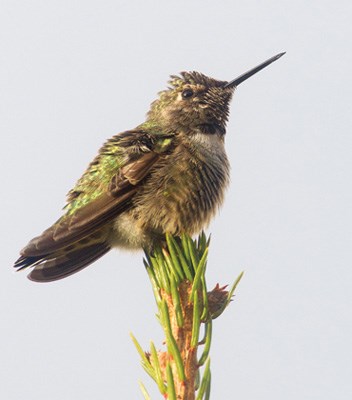IT was a glorious sight to see the North Shore Mountains sparking with a cloak of snow recently.
It was also a reminder that winter has arrived.
Winter is a special season in the lives of birds, with food and weather being the two most important issues, although for some birds, like ducks, it's actually the courting season. Owls too, start early with breeding chores and the tiny Anna's hummingbird will be nesting by February (it's true!).
By December, birds that spent the winter locally have 'settled in' till spring. This is one reason, i.e. stable bird populations, that the annual Christmas bird counts are held from mid-December to early January. The North Shore is part of the Vancouver Christmas Bird Count, and Maplewood Conservation Area is a very important part of it. Weather conditions play an important part in what birds are actually counted. For example, if freshwater ponds are frozen over, it will force ducks and geese into salt water habitats like Maplewood's tidal flats.
Not only is it courtship time for ducks like mallards, wigeons and pintails, but they are also in their finest plumages. We have the greatest diversity of waterfowl in winter - we are 'south' to these birds, many of whom come from the far north, and some like the long-tailed duck are from arctic waters. Good places on the North Shore to see a fine variety of waterfowl include Maplewood Conservation Area and Ambleside Park. Watch for scoters (three species), goldeneyes (two species), red-breasted merganser and ruddy duck. On the November bird walk at Maplewood Conservation Area, a family of trumpeter swans landed off Osprey Point. And flocks of Snow Geese have been seen winging their way south - perhaps to the Fraser Delta, or beyond. These are birds that breed in Siberia.
December is also an excellent month to watch for raptors. Snowy owls have made a return to Boundary Bay and there are also good numbers of short-eared owls. Our resident buteo-type (and typical of the group) is the red-tailed hawk, but a northern species that winters locally is called the rough-legged hawk. Watch also for the peregrine falcon, merlin, sharp-shinned hawk and Cooper's hawk (common). Two rarities that show up most winters on the North Shore are the northern goshawk and the gyrfalcon. Skiers and snowshoers in the local mountains should watch for the goshawk - a beautiful member and largest of the accipiter group of bird hunting hawks. Hot Tip!: A superb adult goshawk has been seen at Maplewood in early December.
Small birds that normally occur in December include chickadees, kinglets, finches and sparrows. Black-capped and chestnut-backed are our common chickadees, but there's also a good chance of seeing a mountain chickadee if you watch for it (it has a white line over each eye). Finches like purple and house are commonly seen at bird feeders; along with pine siskins and goldfinches, you might be lucky to spot a few beautiful common redpolls.
Again, if you're a cross country skier or you snowshoe in the North Shore Mountains (if you've never been along a snowy winter trail, you owe yourself a treat). Go with a guide, watch for 'winter finches' like crossbills (red and white-winged) pine grosbeaks, siskins, redpolls and the hard but not impossible to find gray-crowned rosy finch: all these finches can show up at lower elevations too. Sometimes, at Maplewood Conservation Area, red crossbills are seen foraging along the seashore.
. . .
If you are planning to buy birding binoculars for someone, bear a few things in minds - make sure they are waterproof, fog proof, and carry a good warranty (lifetime and no fault).
Enjoy our winter birds, but do so safely. Best wishes and good birding for the New Year.
Al Grass is a Naturalist with Wild Bird Trust of British Columbia, which sponsors free walks at Maplewood Flats Conservation Area on the second Saturday of every month. The next walk is Saturday December 8 - where you can learn more about the wintering birds at Maplewood. Meet at 10 a.m. at Maplewood Flats, 2645 Dollarton Highway (two kilometres east of the Iron Workers Memorial Second Narrows Crossing). Walks go rain or shine. Web-site: wildbirdtrust.org.



